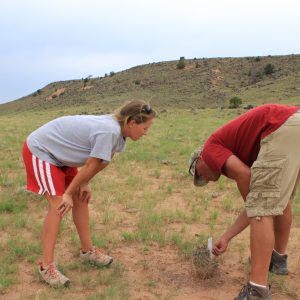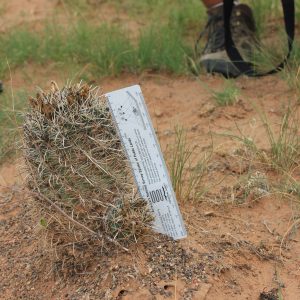- The BLM in Cedar City Utah has given me many opportunities to learn about the diversity of work that is available. Recently I was able to attend Biomass Days in Beaver Utah. This event was gave me a chance to see firsthand the tools and equipment that is being used to combat Pinion/Juniper encroachment. There were also many speakers that discussed the exciting prospects of Bio-Char a product that is made from burning P/J without oxygen. This new product is very promising! There are multiple uses for it Bio-Char, it can be added to mulch and fertilizers as well as being compressed into pellets to be sold as charcoal. Some of the equipment that was demonstrated was the Bull hog, wood chipper, wood chip sorter, and bagging machine. I am also still monitoring the sage grouse in the area using radio telemetry, which I am becoming an expert at.
Daily Archives: 5 October, 2012
Compliancy is paving the way for more than just Wright’s Fishhook cactus
Dustin Rooks, a blonde-haired man in his mid-thirties whose fair skin is painted tan from numerous rendezvous with the sun, greeted me with a wide smile and said, “Boy, did you pick a terrible year to pick seeds, but that’s alright because we have bigger issues — cactus.” I am, in fact, not a boy; having grown up in Colorado with family in the rural midwest, however, I am used to the antiquated country jargon. Dustin is the state botanist for Utah’s Bureau of Land management, and with his laid-back demeanor, one can tell he loves his job. My first day as an intern he takes me to the offices of the other employees at the Richfield BLM. The office is pseudo-divided by cubicles created by the idealists in an attempt to keep people honest; no privacy — no room for shenanigans, as reiterated by the numerous phone conversations heard from afar. Ending where we began, I meet the office manager and was immediately briefed on Central Utah’s cactus dilemma.
In 1979, Sclerocactus wrightiae, also known as Wright’s fishhook cactus, was added to the endangered species list. S. wrightiae is endemic to Utah, thriving in sandy-textured soil — meaning its sole habitat of choice happens to be the badlands of Utah. When listed, the BLM knew they were going to be walking a fine line balancing the necessary monitoring of S. wrightiae populations and upholding their mission to keep the lands open for multi-use. You see, another species that also prefers the badlands is the dirt-biking breed of Homo sapiens. Mentioning Wright’s fishhook cactus to a member of this gloriously dignified group brings a similar reaction as telling a teenager he or she can’t go the party. Anger. Rage. Best of all — rebellion.
Being an endangered species there are certain regulations that must be met, including (but not limited to) closing off areas where Wright’s fishhook cactus is found. This is unwelcoming news for enthusiasts that have been getting down-and-dirty riding on these grounds for decades. As of now, Dustin is the one who is trying to protect the survival of Wright’s fishhook while ensuring BLM’s public lands remain just that, public. Compliancy is good news for both Dustin and the off-highway vehicle (OHV) community. With continued trend of compliancy and growing survival rates for S. wrightiae, the day is approaching where the OHV fanatic can once again hop on their gold chariot and ride into the sun.
- Allison and Dustin taking measurements of one of the largest Wright’s fishhook cactuses we’ve found.
Lessons learned
I had an argument with a coworker this past week. The issue was not really anything of great importance, but a result of the fatigue and irritability that can result from field work. This event lead me to examine some specific considerations surrounding my current and future employment as a field biologist. Field work has a certain set of demands infrequently experienced in other work environments. One obvious, yet significant, aspect of field work is the outdoor environment. Local climate and inclement weather can cause general physical discomfort. Physical discomfort often leads to a negative emotional response. I have learned that my patience and composure are tried by the relentless heat I’ve experienced this summer. I have learned to be aware of shifts in my temperament caused by the heat. I know that I cannot prevent the physical discomfort, therefore the only thing under my control is my emotional response to it.
A second aspect of field work is working closely with the same person/group of people daily. Under these circumstances individuals rapidly get to know each other. We learn to get along almost out of necessity, in order to get the work done, but also to make the experience pleasant for everyone. I think that confrontation will inevitable arise during this process. Individuals of a team must voice their concerns or feelings to make others aware of them if they have been offended or are feeling uncomfortable. The key in this situation is to speak up early, thus to prevent the build up of resentment or grudges. I’m glad this internship has provided me with the opportunity to grow in personal and emotional wisdom as well as botanical and scientific knowledge. Thanks CLM!
Seed collecting in northeast Nevada
Here in Carson City we’ve been staying very busy this field season. We’ve been doing a wide variety of projects, but most recently we’ve been doing many seed collections. We were scouting and collecting on the east side of the Pine Nut Mountains last week, and camping there at night! Our group successfully made about 20 collections, including Woods’ rose, fourwing saltbush, milkweed, and scabland penstemon. It was a great and productive trip. I really enjoy the field work we do because we get to go to so many remote places that we wouldn’t otherwise see!




